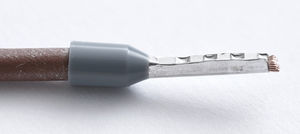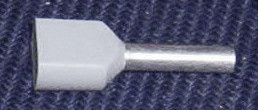Difference between revisions of "Terminal block connections, recommended practice"
(created) |
(→Wire ferrules: +image) |
||
| Line 3: | Line 3: | ||
===Wire ferrules=== | ===Wire ferrules=== | ||
| − | [[File: | + | [[File:Wire ferrule.jpg|thumb|300 px|Wire ferrule crimped onto a stranded conductor]] |
Wire ferrules are recommended for both stranded and solid wire, to prevent contact loss due to wire deformation and copper oxidation. In the case of stranded wire, ferrules also prevent shorts caused by splayed or broken strands. | Wire ferrules are recommended for both stranded and solid wire, to prevent contact loss due to wire deformation and copper oxidation. In the case of stranded wire, ferrules also prevent shorts caused by splayed or broken strands. | ||
A ferrule effectively increases the wire diameter. When selecting a ferrule, make sure it is not too large to insert into the TB. | A ferrule effectively increases the wire diameter. When selecting a ferrule, make sure it is not too large to insert into the TB. | ||
| + | |||
| + | [[File:Twin wire ferrule.jpg|thumb|300 px|Twin wire ferrule]] | ||
To terminate a wire with a ferrule, insert it into the ferrule and crimp the ferrule to make a solid wire end. A twin wire ferrule is recommended when two wires will be connected to the same TB terminal; insert both wires into the ferrule and crimp. Use the proper crimp tool, which will leave a textured surface that is readily gripped by the terminal. After crimping, insert the ferrule into the TB and tighten it in place. | To terminate a wire with a ferrule, insert it into the ferrule and crimp the ferrule to make a solid wire end. A twin wire ferrule is recommended when two wires will be connected to the same TB terminal; insert both wires into the ferrule and crimp. Use the proper crimp tool, which will leave a textured surface that is readily gripped by the terminal. After crimping, insert the ferrule into the TB and tighten it in place. | ||
Revision as of 17:38, 9 March 2022
The following recommendations apply to spring and screw cage terminal blocks (TBs).
Contents |
Wire ferrules
Wire ferrules are recommended for both stranded and solid wire, to prevent contact loss due to wire deformation and copper oxidation. In the case of stranded wire, ferrules also prevent shorts caused by splayed or broken strands.
A ferrule effectively increases the wire diameter. When selecting a ferrule, make sure it is not too large to insert into the TB.
To terminate a wire with a ferrule, insert it into the ferrule and crimp the ferrule to make a solid wire end. A twin wire ferrule is recommended when two wires will be connected to the same TB terminal; insert both wires into the ferrule and crimp. Use the proper crimp tool, which will leave a textured surface that is readily gripped by the terminal. After crimping, insert the ferrule into the TB and tighten it in place.
Stranded wire
Stranded wire:
- Do not insert bare strands directly into the TB.
- Do not apply solder to the strands.
- Use a wire ferrule. Insert the strands into the ferrule and crimp to make a solid end. Insert the ferrule into the TB.
- Provide a strain relief if the wire will be flexed or subjected to pulling forces.
Solid wire
Solid wire:
- The use of a wire ferrule is optional.
- It may be acceptable to insert bare wire into the TB. This should be avoided if the wire is subjected to vibration or pulling forces, or if the wire would be significantly deformed by the compressive force of the TB jaws.
- Do not flex the wire after installation.
Strain relief
It is recommended to secure all wires with strain reliefs. This is especially important if the wires will be subjected to vibration or pulling forces.

